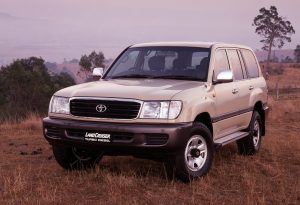Recalls: Toyota 100-Series Landcruiser
Overview
Manufacturers, or importers, issue recalls for defects or faults which have the potential to cause injury. Generally, manufacturers will inform the original buyers if their vehicle is subject to a recall and of the steps required to remedy the defect or fault. Please note that the recalls below (if any) are for Australian-delivered vehicles only. Furthermore, the number of recalls should not be taken as an indication of a model’s reliability or its safety more generally.
Recalls: Toyota 100-Series Landcruiser
1998-01 Toyota 100-Series Landcruiser: spare wheel winch cable could fray
In June 2002, a recall was issued for Toyota 100-Series Landcruiser models manufactured from 7 January 1998 to 2 September 2001. If these vehicles were driven regularly on rough, corrugated roads at high speeds and for long distances, the spare wheel winch wire cable could become frayed due to road-transmitted vibrations (PRA 2002/5421).
1997-04 Toyota 100-Series Landcruiser: bullbar mounting bracket welds could break
In June 2006, a recall was issued for Toyota 100-Series Landcruiser models manufactured between December 1997 and October 2004 due to the welds on the bulbar adaptor mounting brackets potentially fracturing in heavy winching operations. At worst, the bulbar could become detached from the vehicle (PRA 2006/8591).
1997-05 Toyota 100-Series Landcruiser: front brake rotor bolts could loosen
In March 2007, a recall was issued for FZJ105, HZJ105, UZJ100 and HDJ100 models Toyota Landcruisers manufactured from 30 September 1997 to 5 December 2005. When these vehicles were operated in severe conditions with repetitive and forceful braking applications, excessive forces applied to the brake rotor may loosen the front brake rotor bolts. If the vehicle continued to be driven in this condition, one or more bolts may loosen further, becoming loose and producing a rattling noise (PRA 2007/9087).
2002-06 ‘model year’ Toyota 100-Series Landcruiser: potential short circuit
In May 2008, a recall was issued for model year 2002 to 2006 Toyota 100-Series LandCruiser vehicles. In these vehicles, there was a possibility that the dashboard wire harness may be abnormally twisted, changing its inteded routing in the vehicle and allowing contact with the unprotected edge of the pedal support bracket. If the vehicle was continuously driven on corrugated roads in this condition, the wire harness would rub against the pedal support bracket, damaging the wire insulation cover and resulting in a shirt circuit and blown fuse (PRA 2008/10050).
2005-07 Toyota 100-Series Landcruiser: snap ring on steering shaft could disengage
In July 2010, a recall was issued for Toyota 100-Series LandCruiser Sahara vehicles that were manufactured from May 2005 to August 2007. In these vehicles, the snap ring on the steering shaft could disengage when the vehicle experienced an unusually severe impact to the front wheels such as striking a deep pothole (PRA 2010/11856). The recalled vehicles had VINs in the following ranges:
- Model Code HDJ100: JTEHC05J#04030122 to JTEHC05J#04042432; and
- Model Code UZJ100: JTEHT05J#02080021 to JTEHT05J#02117147.
Toyota 100-Series LandCruiser: incorrect specification airbag
In September 2017, a recall was issued for Toyota 100-Series LandCruiser vehicles because an incorrect specification airbag may have been installed during the vehicle assembly process. In the event of a collision, the incorrect specification airbag increased the risk of injury to vehicle occupants. For the VINs of the recalled Toyota LandCruiser vehicles, please see PRA 2017/16303.
Problems and faults: Toyota 100 Landcruiser
Overview
This section identifies potential problems, causes and fixes based on the experiences of owners and repairers, online sources and technical service bulletins. This information is provided solely for reference purposes and AustralianCar.Reviews recommends that only properly qualified persons carry out repairs or modifications. Furthermore, the number of items below should not be taken as an indicator of a model’s reliability or the frequency with which they may occur.
To report a problem or fault to the AustralianCar.Reviews team, please use the Contact Us form. Note that AustralianCar.Reviews does not offer advice on automotive problems or disputes; such enquiries will not receive a reply. For vehicles purchased from dealers after 1 January 2011, please see our Australian Consumer Law fact sheet.
CV joints and boots
The front axles have four ‘constant velocity’ or CV joints: two inboard and two outboard. The CV joints are encased by rubber boots that maintain the CV joints’ supply of grease on the inside and protect against dirt and water ingress. Over time, however, the boot may develop cracks or splits which allow foreign material to enter and damage the CV joint. Symptoms of cracked or split CV boots include:
- A greasy or oily substance on the surface below the vehicle or around the front wheels; or,
- Abnormal clicking noises while driving.
While the driveshaft and CV joint normally have to be removed to replace a boot, the Toyota split boot kit can be fitted without removing the driveshaft.
Toyota 100-Series Landcruiser: other problems and faults
- For the 100-Series LandCruiser, the independent front suspension was susceptible to damage where the suspension contacted the bump stops. As a result, separate companies manufactured strengthened lower wishbones to prevent cracks developing.
- Broken front differentials were reported in both 100- and 105-Series models. For the 100-Series, broken differentials were most prevalent for 1997-99 models with a 2-pinion front differential as the pinion gear would flex away from the ring gear under load shocks. In late 1999, a more robust 4-pinion front differential was introduced.
- For the 4.7-litre V8 petrol engine, a ticking sound after start-up may be due to cracked exhaust manifolds.
- A buzzing noise from the air conditioning system may be due to a defective expansion valve. If so, the valve and an attached must be replaced.
- The transmission may make a chattering noise when shifting from reverse to neutral or park – this can be fixed by installing an additional check ball in the valve body.




